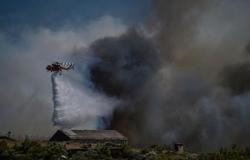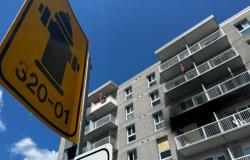Aerial bombardments and artillery fire targeted the Gaza Strip from north to south on Tuesday, where Israel continues its offensive against Hamas relentlessly after the announcement of the death of four hostages killed in the Palestinian territory.
Despite calls for a ceasefire from around the world, the contradictory demands of the two camps seem to doom to failure a plan presented Friday by American President Joe Biden, after almost eight months of war.
Israel has promised to eliminate Hamas, in power since 2007 in the Gaza Strip and author of a bloody attack on its soil on October 7, while the Palestinian Islamist movement is demanding a total ceasefire.
Nearly a month after the start of a ground offensive on Rafah, a border town with Egypt in the south of the territory, presented by Israel as the final stage of its war against Hamas, fighting has resumed across the Gaza Strip.
On Tuesday, airstrikes targeted eastern and central Rafah, according to witnesses and a local official. A witness reported artillery fire in Khan Younes, a ruined town a few kilometers from Rafah.
Read also | Four Israeli hostages die in Gaza, truce in doubt
Deadly bombings hit Gaza City in the north and the Palestinian camp of Bureij in the center of the territory. In Deir el-Balah, still in the center, eight police officers were killed, according to the Hamas press service.
The army announced that its air force had struck “65 terrorist targets” the day before.
The plan presented by Joe Biden, proposed according to him by Israel, provides for a six-week ceasefire accompanied by an Israeli withdrawal from densely populated areas of Gaza, the release of certain hostages, notably women and the sick, and Palestinian prisoners held by Israel.
This plan aims to establish a “permanent” ceasefire in a later phase, provided that Hamas “respects its commitments”, according to Mr. Biden.
But Qatar, which plays the role of mediator, said on Tuesday it was waiting for “a clear position” from Israel, which seemed to distance itself from this plan.
Read also | Gaza: Washington thanks HM the King for his support for Biden’s initiative
Under very strong pressure from public opinion and his far-right allies, Prime Minister Benjamin Netanyahu reaffirmed, after the announcement of the plan, his intention to “destroy” Hamas and obtain the release of “all the hostages” kidnapped on October 7, before a ceasefire.
Israel, still traumatized, learned on Monday of the death of four hostages kidnapped in kibbutzim in the south of the country, probably killed during the fighting in the Khan Younes sector and whose bodies are still in the hands of Hamas, according to the army.
On Monday, hundreds of demonstrators gathered in Tel Aviv accused the government of having “abandoned” the hostages. “The blood is on each of them, these are people who could have returned home alive, and not in coffins,” said Yifat Kalderon, a cousin of hostage Ofer Kalderon.
“I urge all parties to immediately reach an agreement to achieve a ceasefire and release the hostages. There is no alternative: any delay costs lives every day,” UN Middle East envoy Tor Wennesland said on Tuesday.
The war was sparked by the unprecedented attack on October 7, which resulted in the deaths of 1,194 people in Israel, the majority civilians, according to an AFP count based on official Israeli data.
Of the 251 people taken as hostages, 120 are still detained in Gaza, of whom 41 are dead, according to the Israeli army.
In retaliation, Israel declared war on Hamas, which it considers a terrorist organization along with the United States and the European Union.
His army launched an offensive in the Gaza Strip that has so far killed 36,550 people, including 71 in 24 hours, according to data from the Health Ministry of the Hamas-led Gaza government.
After several months of ground offensive, Israeli forces entered Rafah on May 7, pushing a million people to flee, and have since taken control of strategic sectors, such as the Rafah border crossing with Egypt and the Philadelphia Corridor, a road that borders the border on the Palestinian side.
But over the weeks, fighting has resumed in several sectors of the north and center of the Gaza Strip, which the army had nevertheless assured to control, testifying to a “failure” of the Israeli strategy, underlines Michael Milshtein, specialist Palestinian issues at Tel Aviv University.
“Since January or February, Israel has followed a strategy of very precise, limited operations, instead of remaining on the entire territory,” explained this researcher. “This strategy has failed,” he added.
Worsening the humanitarian crisis in the besieged territory, the offensive on Rafah led to the closure of the crossing with Egypt, crucial for the entry of international aid.
The NGO Oxfam denounced on Tuesday the “terrible” sanitary conditions in the Al-Mawasi area, near Khan Younes, where hundreds of thousands of Palestinians are refugees who on average only have one toilet for 4,000 people.
“There is no clean water, people are forced to use sea water,” describes Meera, an Oxfam worker who has taken refuge in Al-Mawasi.
While “1.7 million inhabitants are now concentrated in less than a fifth of the Gaza Strip”, Israeli bombings and “deliberate” blockades “make it practically impossible” to access civilians “trapped and hungry,” denounces Oxfam.
In the north of Israel, firefighters and the army are meanwhile trying to control forest fires that appeared after rocket fire from Lebanon, in the border area where exchanges of fire are almost daily between the Israeli army. and the Lebanese Hezbollah, on the sidelines of the war in Gaza.
Challenge (with AFP)






